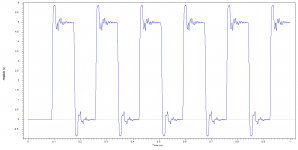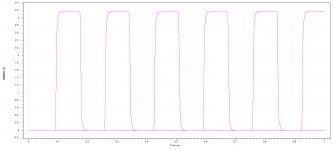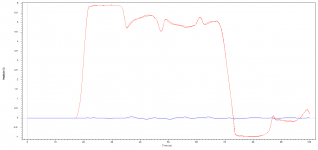Simple - It may have different performance characteristics between each direction explained by variations in impedance along the cable which are not symmetrical about it's mid-point. I didn't say it wasn't audible - I made no claim in this regard.
But wouldn't it be more intelligent to first check whether there is an audible difference when the direction is reversed, before speculating of what 'it' could be?
Nothing in this world is perfect, so I'm sure you can find a parameter that is different depending on direction. But unless it is audible, who cares?
Identifying 'a difference' and suggesting it 'might' be audible, without putting your money where your mouth is and actually checking for audibility, is a very cheap and lazy way to continue a discussion that is totally irrelevant. A waste of bandwidth.
Jan
But wouldn't it be more intelligent to first check whether there is an audible difference...
Identifying 'a difference' and suggesting it 'might' be audible, without putting your money where your mouth is and actually checking for audibility, is a very cheap and lazy way to continue a discussion that is totally irrelevant. A waste of bandwidth.
Jan
Same point I've been making on Bybees and various other audiophile claims. Nice to see I'm in good company.
In regards to the 'ears are too sensitive' argument. Our hearing is c**p. A dog has good ears. A bat even more so. Our brain is wonderful though. Fills in all the gaps for us. Even if the dynamic range of speakers is less than our hearing, the brain fills things in. But despite how good our brain is, it is also very gulible, easily tricked, and will hear things that aren't there. Our hearing, despite being blunt, is still moderatly sensitive to dynamics, hence whilst stuff not audibly louder, but measurably louder will always sound better.
In regards to the 'ears are too sensitive' argument. Our hearing is c**p. A dog has good ears. A bat even more so. Our brain is wonderful though. Fills in all the gaps for us. Even if the dynamic range of speakers is less than our hearing, the brain fills things in. But despite how good our brain is, it is also very gulible, easily tricked, and will hear things that aren't there. Our hearing, despite being blunt, is still moderatly sensitive to dynamics, hence whilst stuff not audibly louder, but measurably louder will always sound better.
Bingo!
Jan
Some quick sims:
600mm-mismatch-200mm
200mm-mismatch-600mm
and terminated quickly to remove the effects of the mismatch.
Sorry about the different sizes did it in a rush as I am away on site (doing ANR stuff) and don't have access to my earlier SPDIF stuff.
In the real world though cables tend not to have an impedance mismatch, these will occur at connection points. I will also do better sims when I get the time and match the images better.
600mm-mismatch-200mm
200mm-mismatch-600mm
and terminated quickly to remove the effects of the mismatch.
Sorry about the different sizes did it in a rush as I am away on site (doing ANR stuff) and don't have access to my earlier SPDIF stuff.
In the real world though cables tend not to have an impedance mismatch, these will occur at connection points. I will also do better sims when I get the time and match the images better.
Attachments
Last edited:
In regards to the 'ears are too sensitive' argument. Our hearing is c**p. A dog has good ears. A bat even more so. Our brain is wonderful though. Fills in all the gaps for us. Even if the dynamic range of speakers is less than our hearing, the brain fills things in. But despite how good our brain is, it is also very gulible, easily tricked, and will hear things that aren't there. Our hearing, despite being blunt, is still moderatly sensitive to dynamics, hence whilst stuff not audibly louder, but measurably louder will always sound better.
A very heretical view😉
It always amazes me how the GEB can do digital with their ears only😀
Oh the mismatch in the above example is over 30% - 75R down to 50R, never going to happen in a real world cable, unless you really twist the co-ax and change the geometry between the inner cable/outer sheaf.
To model a twisted pair will take longer and I don't have time at the moment.
To model a twisted pair will take longer and I don't have time at the moment.
Last edited:
It is in the digital domain and the distortion is nowhere near the receiver threshold so there will be insufficient induced jitter to effect data recovery.
Inaudiable.
Inaudiable.
Er yes the original claims are for analogue signals. Impedance mismatches can be used to determine breaks in cables. As such even a 5% impedance mismatch in a co-axial cable will be down to some damage. When time permits I will do a more complex model of the cable, and try and model different types (co-ax, twisted pair etc.) like all simulation it does take time putting in all the parameters. here is a 5% mismatch superimposed with the slight difference shown in blue:
Will any of this be audible, no and I have also used worse case drivers and receivers and no termination, as soon as you add termination to match the line the cable becomes invisible.
Also did some modelling of 500mm Vs 1500mm cables, the 1500mm plot looks worse than the 500mm so the myth that a longer cable for SPDIF doesn't seem to hold water either, but again terminate the line and the problems go away (apply engineering practice and things seem to work!).
Will any of this be audible, no and I have also used worse case drivers and receivers and no termination, as soon as you add termination to match the line the cable becomes invisible.
Also did some modelling of 500mm Vs 1500mm cables, the 1500mm plot looks worse than the 500mm so the myth that a longer cable for SPDIF doesn't seem to hold water either, but again terminate the line and the problems go away (apply engineering practice and things seem to work!).
Attachments
Last edited:
Marce, I don't know what you are showing in your simulations - the deviation from a ideal square wave of such impedance mismatches?
Can you bring me through your logic then to declaring such perturbations as inaudible?
Can you bring me through your logic then to declaring such perturbations as inaudible?
Can you bring me through your logic then to declaring such perturbations as inaudible?
It may be time to do your own research on digital interfaces. Remember that there's only one place in a DAC where jitter counts (unless it's so pathologically gross that the receiver loses lock).
What, cause they are inaudible, this is a square wave, there is no correlation between the shape of a square wave and the resultant sound that comes out of a DAC, unless they are that bad to cause drop outs. The waves shown are worse case scenarios, but even these will be read and the data recovered correctly. How can these signals sound different from a neater wave, the crossing points where the gates will switch are the same for waves with ringing as they are for waves with the high frequency content attenuated by termination.
How can you think there would be a sound difference, for that you would have to put a DPS between the SPDIF output and the SPDIF input!
I am showing the effects of a severely mismatched cable being turned round, basic digital signal transmission, terminating the lines makes everything pretty so they are shown in the raw state with no termination, a driver that is over the top (faster rise time than required) so that the minute difference can be seen, and it is minute, but even these worse case scenarios will sound exactly the same...
Neither case will increase jitter to a level where it becomes noticeable, if at all.
Further looking at pretty pictures of waveforms in a simulator is occasionally part of my job, we only tend to do it on DDR memory interfaces and such like real high speed interfaces, and occasionally clocks, most people wont pay for simulation though it costs...so they just go with the layout.
The directivity claim is for analogue signals, and is based on the micro-diodes between the crystal boundaries.
How can you think there would be a sound difference, for that you would have to put a DPS between the SPDIF output and the SPDIF input!
I am showing the effects of a severely mismatched cable being turned round, basic digital signal transmission, terminating the lines makes everything pretty so they are shown in the raw state with no termination, a driver that is over the top (faster rise time than required) so that the minute difference can be seen, and it is minute, but even these worse case scenarios will sound exactly the same...
Neither case will increase jitter to a level where it becomes noticeable, if at all.
Further looking at pretty pictures of waveforms in a simulator is occasionally part of my job, we only tend to do it on DDR memory interfaces and such like real high speed interfaces, and occasionally clocks, most people wont pay for simulation though it costs...so they just go with the layout.
The directivity claim is for analogue signals, and is based on the micro-diodes between the crystal boundaries.
Last edited:
Marce,
The clock is a recovered from the SPDIF datastream so it's not just a simple data integrity issue as you are portraying.
Anyway, you have stated that the discussion is limited to analogue cable directivity so sorry if I rocked the boat
The clock is a recovered from the SPDIF datastream so it's not just a simple data integrity issue as you are portraying.
Anyway, you have stated that the discussion is limited to analogue cable directivity so sorry if I rocked the boat
Dweeb98, the clock will be recovered from those waveforms, and yes it is simple signal integrity (though I would not use the term simple) but it is all signal integrity including the clock, and it is as I am portraying...(Manchester encoding is used in other interfaces, not just SPDIF) you have to ask yourself why am I sat here with a £12K add on to the PCB design layout software I use...
http://www.quadrasol.co.uk/useruploads/files/signal_integrity_datasheet_2012.pdf
But I can also simulate eye diagrams etc etc. The reason is that I have harder and faster interfaces than SPDIF to contend with where signal integrity is far more critical than a pretty simple SPDIF interface, and where jitter really is critical so a few years playing with getting signals from a to b on PCBs and between PCBs gives you a feel for what the data should look like and where you are going to have problems. There was another discussion where someone was convinced that looking at the square wave would tell him what effect this would have on the sound, this really is not the case as there is no correlation between the two, there are things you have to watch out for with the shape of the digital wave, such as monotonicity, ringing, levels etc. and these can have an effect but within pretty wide boundaries the data will get through unscathed that is why digital signal and data transmission is the preferred way. But some audiophiles do like to see more in the digital waves appearance than is actually there.
You have not rocked the boat.
http://www.quadrasol.co.uk/useruploads/files/signal_integrity_datasheet_2012.pdf
But I can also simulate eye diagrams etc etc. The reason is that I have harder and faster interfaces than SPDIF to contend with where signal integrity is far more critical than a pretty simple SPDIF interface, and where jitter really is critical so a few years playing with getting signals from a to b on PCBs and between PCBs gives you a feel for what the data should look like and where you are going to have problems. There was another discussion where someone was convinced that looking at the square wave would tell him what effect this would have on the sound, this really is not the case as there is no correlation between the two, there are things you have to watch out for with the shape of the digital wave, such as monotonicity, ringing, levels etc. and these can have an effect but within pretty wide boundaries the data will get through unscathed that is why digital signal and data transmission is the preferred way. But some audiophiles do like to see more in the digital waves appearance than is actually there.
You have not rocked the boat.
PLL.
Indeed, all SPDIF receivers PLLs, perfectly recover a jitter free clock 😀
Anyway, as Marce states, this is about analogue cable directivity, I will desist.
Indeed, all SPDIF receivers PLLs, perfectly recover a jitter free clock 😀
Other way around.
The original claims are referring to analogue cables, but any cable should not be directional, the claims though regarding audio cables is a hear the difference only, usually with the caveat that they know what they hear!
This is an example of these myths that distract from the real issues in audio reproduction and there are enough of them without finding more gremlins to worry about, though there are some who seem to thrive on constant worry regarding their system, and would find gremlins to worry about with a perfect system:
cable directivity and digital nasties - farfetched - Cable Asylum
This is an example of these myths that distract from the real issues in audio reproduction and there are enough of them without finding more gremlins to worry about, though there are some who seem to thrive on constant worry regarding their system, and would find gremlins to worry about with a perfect system:
cable directivity and digital nasties - farfetched - Cable Asylum
- Status
- Not open for further replies.
- Home
- Member Areas
- The Lounge
- Funniest snake oil theories



